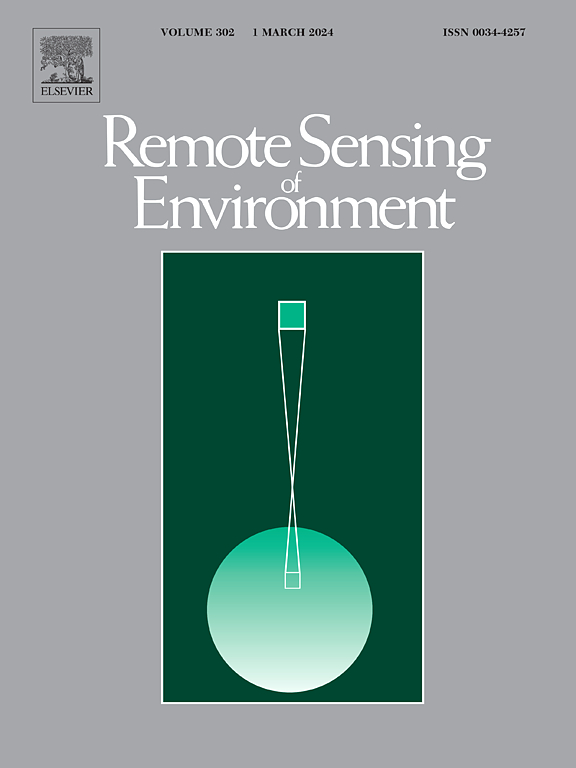青藏高原多年冻土区35年退行性融化滑坡动态追踪
IF 11.1
1区 地球科学
Q1 ENVIRONMENTAL SCIENCES
引用次数: 0
摘要
青藏高原多年冻土退化引发了广泛的退行性融化滑坡,影响了水文、碳固存和基础设施的稳定性。迄今为止,仍缺乏对整个青藏高原RTSs的长期监测,解冻动态和综合驱动因素尚不清楚。本文利用时间序列Landsat图像和变化检测算法,确定了1986 - 2020年青藏高原多年冻土区的rts。利用现有的RTSs清单和高分辨率历史图像对识别结果进行验证,RTSs干扰像素的时间验证显示出较高的准确性。研究区共发现3537个RTSs,总面积5997 ha,是1986年的26倍,其中2010年以后形成的RTSs占69.2%。RTSs多位于海拔4500 ~ 5300 m的缓坡(4 ~ 12°)上,以高寒草地和高寒草甸为主。RTSs面积的年际变化与最低气温、平均地表温度和年融化指数呈显著正相关,与下行短波辐射减少呈显著负相关。从空间上看,RTSs在土壤含水量高、活性层较浅的地区更为常见。Landsat图像捕获了青藏高原上绝大多数的RTSs,并揭示了年际扰动的细节,但30米的分辨率仍然不足以描绘一些微观尺度(<;0.18 ha) RTSs。探测到的RTSs对TP的干扰将有助于灾害管理和碳反馈评估,我们的研究结果为气候变化和永久冻土环境对RTSs形成的影响提供了新的见解。本文章由计算机程序翻译,如有差异,请以英文原文为准。
Tracking 35-year dynamics of retrogressive thaw slumps across permafrost regions of the Tibetan Plateau
Permafrost degradation on the Tibetan Plateau (TP) has triggered widespread retrogressive thaw slumps (RTSs), affecting hydrology, carbon sequestration and infrastructure stability. To date, there is still a lack of long-term monitoring of RTSs across the TP, the thaw dynamics and comprehensive driving factors remain unclear. Here, using time-series Landsat imagery and change detection algorithm, we identified RTSs on permafrost regions of the TP from 1986 to 2020. Existing RTSs inventories and high-resolution historical imagery were employed to verify the identified results, the temporal validation of RTSs disturbance pixels demonstrated a high accuracy. In the study area, a total of 3537 RTSs were identified, covering a total area of 5997 ha, representing a 26-fold increase since 1986, and 69.2 % of RTSs formed since 2010. Most RTSs are located on gentle slope (4–12°) at elevations between 4500 m and 5300 m, with a tendency to form in alpine grassland and alpine meadow. Annual variations in RTSs area exhibited a significant positive correlation with minimum air temperature, mean land surface temperature, and annual thawing index, while it showing a significant negative correlation with the decrease in downward shortwave radiation. Spatially, RTSs were more common in areas with higher soil water content and shallower active layer. Landsat imagery captured the vast majority of RTSs on the TP and revealed interannual disturbance details, but the 30 m resolution remains inadequate for delineating the refined boundaries of some micro-scale (< 0.18 ha) RTSs. Detected RTSs disturbances on the TP will aid in hazard management and carbon feedback assessments, and our findings provide novel insights into the impacts of climate change and permafrost environments on RTSs formation.
求助全文
通过发布文献求助,成功后即可免费获取论文全文。
去求助
来源期刊

Remote Sensing of Environment
环境科学-成像科学与照相技术
CiteScore
25.10
自引率
8.90%
发文量
455
审稿时长
53 days
期刊介绍:
Remote Sensing of Environment (RSE) serves the Earth observation community by disseminating results on the theory, science, applications, and technology that contribute to advancing the field of remote sensing. With a thoroughly interdisciplinary approach, RSE encompasses terrestrial, oceanic, and atmospheric sensing.
The journal emphasizes biophysical and quantitative approaches to remote sensing at local to global scales, covering a diverse range of applications and techniques.
RSE serves as a vital platform for the exchange of knowledge and advancements in the dynamic field of remote sensing.
 求助内容:
求助内容: 应助结果提醒方式:
应助结果提醒方式:


